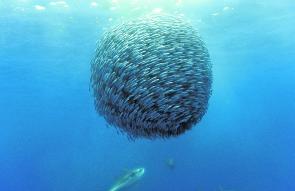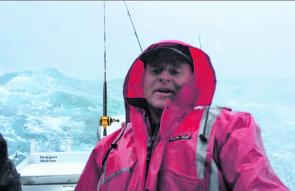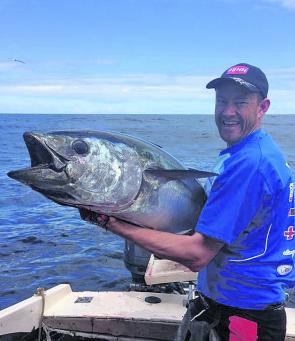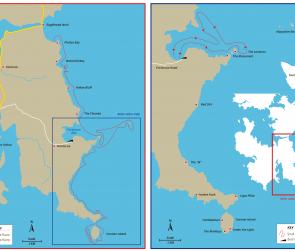Southern bluefin tuna scene in Tasmania has always been popular across Australia, but it is really starting to attract some broader attention. This is probably due to social media spreading the word and showing the nation how many cracking reasons to fish Tasmania’s tuna run.
The more time spent fishing on the mainland offshore, the more I see how lucky and spoilt we are in Tasmania. The grounds we can target bluefin tuna are so close to the ramps of the south east coast, mainland people I speak to barely believe it.
The coastline also lends itself to being quite safe and comfortable for all levels of experience. There is often quite a number of ways and areas to fish should the wind and weather be a bit ordinary. This is not something you can do if you are 20nm+ offshore.
The fishing in Munroe’s Bight is so close and often protected that it must take some getting used to for some when they first experience it.
It is again something Tasmanians all take for granted. It can be a very long day travelling looking for tuna and if the gods are not with you, quite boring, but the next minute you can turn a corner and the views and scenery are spectacular from the ocean’s perspective. If you have nothing to look at but open expanse of sea the day can drag on forever and ever, sapping energy and concentration. On the grounds in Tasmania there is always something spectacular to take in.
Pirates Bay out to the Hippos and all the way along Munroes Bight to Tasmania Island will have you entertained with the sort of geographical eye candy that makes calendar printers swoon. This keeps you alert and engaged so when that bird feed appears or the line screams you are ready to go.
Tassie has had some fantastic seasons of late and the school size bluefin have been plentiful and quite easy to find.
School fish when feeding on bait really fire up the birds and this creates a visual spectacle that is easy to locate. These feeds can be inshore or out to sea, so keep your eyes up.
While the schoolie size SBT get the anglers excited, nothing fires the fishing scene up like the first jumbo capture. These fish have been frequenting Tasmanian shores in numbers not seen in ages. Gone are the myths of these big fish only travelling in small groups. They have come in big numbers and feed hard. Stay as long as the bait will hold them and then power off.
Traditionally in Tasmania we have a 4-6 month season usually starting around the end of February and often running through to August.
I say traditionally as last season just went on and on. Leo Miller managed to catch the first reported Bluefin for this season on the 28 January so fingers-crossed he had some cobbers. What is very interesting is that Leo caught the fish at 500m of water depth while chasing a swordfish – crazy stuff indeed!
Eaglehawk Neck has a solid reputation for producing record catches of SBT and the area holds a lot of quality bluefin. This is due to its ability to attract and hold baitfish on the many sea structures that abound the area. Depending on the time of year the bait can vary from squid, redbait, mackerel, sauries and even mini leatherjackets.
Yes, mini leather jackets were seen last season in the bellies of many fish. Pete Bailey who fishes with me was very keen to hammer a single nail on top of some of our hardbodies to replicate a leatherjacket. Thankfully we didn’t have any hammers on board.
Eaglehawk Neck is a very accessible fishing ground and is a great place for anyone at all to come and have a crack. Beginners and the more experienced alike can have a great time out of Pirates Bay or Fortescue Bay looking for tuna.
Overheads as well as bigger spinning reels will allow you to catch the school size fish, which are plentiful. It’s when the jumbos come to town that the traditional overheads come into their own. These overheads have a lever drag which you can pre set and adjust as the fight goes on. Big spinning reels are harder to judge critical line drag with the precision needed when fishing a particular line class.
The following is a simple circuit of the Necks main fish holding areas. Weather permitting, traveling this route should have you come across fish or get you to parts of the seascape that a bird feed is easy to see and work over. If you do find a fish or two, make sure the skipper marks that point on the sounder and you get back over that spot after landing a fish as soon as you can.
Many great captures are from literally ‘around the corner’. Waterfall Bay is approximately 1.5km from the ramp and is usually by-passed by most anglers on the way to The Rock or Tasman Island.
Waterfall Bay has produced quite a few jumbos in the past few seasons and is always worth a look, especially if the birds are working. It’s the first port of call for us when we are out having a look about.
If we are prospecting and looking for fish we will have a 6 lure spread out and then pair back to 3 or 4 once we know what lure they seem to be favouring. Reducing the amount of lures once the fish are located allows you to turn on the GPS mark, and it also speeds up the ability to get lures back in the water.
Next stop heading south and another place renowned for holding bait is Yellow Bluff and the area to the east of called Foxies Reef. This rock step runs for around 2km seaward, and is also quite often forgotten about in the haste to get the more traditional fishing grounds.
Generally Waterfall and Yellow Bluff are usually less occupied by seals and quite often allow the angler to run a lighter line class and battle the fish for longer without being interfered with by our fury little friends.
If you are having no luck then move further to the mouth of Fortescue Bay, as it is always worth a look and a good spot to drop the spread in about the area of the Thumbs and drag them through to the Lanterns, especially later in the season.
Fortescue Bay is worth a mention to the smaller boat owner. There are very few areas in Australia, if any, as safe to fish for SBT than this area. The bay is sheltered from most directions and has a nice boat ramp to launch from. Given a good weather forecast, even an open dingy can have a crack at catching some bluefin.
Heading out through the mouth of Fortescue Bay with your spread already set you will get a very clear picture as to conditions. Should they be favourable, a clockwise rotation over to the Thumbs, across the open water to the Lanterns and repeat will have you on to the tuna.
Good weather and your confidence will have you reaching out further towards the Little Hippo and back into the Lanterns.
Big Hippolyte Rock is a world-renowned southern bluefin tuna haunt and lies further EAST of Fortescue Bay in full view. Big and Little Hippo rocks are bait magnets and in turn attract a lot of attention from fish that like to feed heavily on the pelagic bait that hold up on the undersea bottom formations and transitions. You will pick up tuna anywhere in and around the rock. We tend to spend a lot of time dragging lures around the southwestern side of the Hippolyte and down and around the little rock.
It is a fantastic place to start and the venue for a lot of people to catch their first ever SBT. However, there are a couple of spots to be wary. Be sure to keep an eye on the reef off the far southeast tip of Big Hippo as it has caught out a few skippers and in a heavy swell show caution to the reef in between the Big Hippo and Little Hippo.
When the ‘Rock is not rocking’ try dragging your lures back over to the Lanterns and down the southern side through into Munroe Bight. There are some named locations that are worth a try, the first of these being Red Dirt. These areas have nicknames from the locals and charter operators and are always worth a try due to past captures.
The next stop heading south is ‘The W’, while not known to many it has accounted for some good jumbo sized tuna over the years.
Keep pressing south and Cape Pillar is the next hot spot and a favourite for charter boats, especially in a southerly breeze/swell as it provides good protection and holds good fish as well. This area has excellent water movement due to the meeting of current and tides. This is fantastic to fire the fish up but can also provide some funky sea conditions so be aware. We like to run a line from inside the Pillar and out about 2km due southeast. Working this area over usually produces a fish or two.
The run out and back from The Pillar will give you fair indication if the prevailing weather will allow you to get to Tasman Island for a lap.
Tasman Island is a stunning bookend to the day’s fishing. The area around the island is very fishy and you can pretty well hook up on a SBT anywhere. Work the area over combining tight runs past The Monkeys and an out loop wider to deeper water and back in. Other good spots are under the light and at the Tumble Downs on the northeastern side.
Tasman Island is no place to be caught in freshening breeze and growing swell, add a tide change to the mix and it is far from pretty. Skippers need to be on the ball and keeping an eye on conditions at all times. If the weather is a bit ordinary just put this circuit into reverse and head home the way you came.
The first thing to do when putting a trip together to chase southern blues is make a plan. When traversing out to sea, and maybe to the shelf, it’s more about a weather window than the weekend. No one wants to be out there when it is too windy and rough. Study the weather and take some time off if needed.
If you can manage some time off for good behaviour you will avoid weekend bottlenecks at the boat ramps and when you do get on the water it won’t be a Regatta!
When looking at the weather there are a number of good sources, but most importantly don’t shop around. I see people swapping from one weather forecast app to the next just trying to find the one report they want to see or hear. Pick a site or phone app that you trust and can understand then stick to it. I like BOM for Tasmania as it’s the source relied on for all the other algorithms. But why do weather forecasts vary depending on which app you use?
The forecast process starts with data and observations that come from weather stations around Australia and the regions that affect our weather. Satellites, radar, reports from volunteers, and weather balloons all collect information about the atmosphere and funnel it to the Bureau of Meteorology (BOM).
These details and measurements are fed into super-computers run by the government (BOM), which take those initial conditions and then use mathematical equations to come up with a forecast. There’s no perfect algorithm because Australia is so big that it’s impossible to have observational data for every parcel of air. All weather applications use the same baseline of data, but the outcomes are determined by the experience of the meteorologists and the quality of the super-computers. That’s why I stick with BOM – straight from the horse’s mouth and full of other scientific data that once understood is sensational for weather analysis.
Pack your pride and joy early, not the night before. When shooting for a weather window to go green on, the boat should be packed, stacked and sorted.
This also goes back to planning. If you are going to target a species on a hot bite don’t take every rod you own and every piece of tackle. This is about taking the gear you need and some spares. Five squid rods and a few flatty bashing outfits is not what you want rolling about the boat when hooked up to a southern bluefin. Make sure you have the gear packed nicely and everyone knows where it is stored. When three reels go off on a three way hook up, the last thing you want to be doing is screaming out is ‘where’s the harness?’ ‘where’s the gaff?’. A clean well-organised deck is crucial to fighting a fish in calm conditions and becomes paramount when things get bumpy.
Bird life is only one of the significant signs you should be looking for when trying to find feeding tuna. Surface disturbance and or current lines should also be investigated. Anything floating in the water may be of interest to bait fish so in turn could have some bigger predators hovering about as well. Concentration and attention to detail is most important.
By all means have fun and have a laugh, but be systematic with your sweeps of the ocean and surroundings. It is a long way to come to miss a group of feeding tuna 1nm to your starboard. You will get to sense when the birds you are looking at are up to something. If you see gannets climbing and looking cagey that is the time to get across to them and have a look. Don’t be in too much of a rush to leave a feed that has produced no strikes. Come at it from different angles and work the area over extensively before moving off.
Birds can spot a bait ball from a long way off. With practice you will spot those birds.
Trolling skirted lures is the traditional domain of the bluefin hunt, but if you close your mind to other ideas you will miss a lot of opportunities. There are a numerous reasons to use other tactics at your disposal.
I am a fan of the Sébile range of sub surface lures, but there are plenty of others on the market. Quality and strength is paramount, just make sure it can handle skirted trolling speeds of 5-8 knots with ease. We have run one right under the prop wash on short corner with a lot of success. To maximise the lures deeper running potential you can run them well back in a shotgun position just out of the prop wash. The idea of the sub surface lure is to raise those fish within striking distance.
If the tuna are being stubborn and you feel you need to get deeper down, then use a premium deep diving lure that will run sweet to 5 knots.
Once a decision has been made to raise fish seen on the sounder, slowing down and presenting divers over skirts works well. How many times do we see bait on the sounder and continue to have little or no luck doing the same old thing? If you are not catching fish after doing something for hours, this is the time to do something different. Get the divers back twice as long as you normally would and go half as slow. Troll over those bait schools a couple of times and this may raise those fish that have shut down.
Once you have hooked a fish the hard work has been done, so there is no need to try and rip the fish’s head off and get him to the boat in 10 seconds flat. Get a sense of the size of the fish and play it out. Let the fish run if it wants to, it is hardly going to wrap a pylon or reef section out in deep water. Tire the fish and it will be easier to land later.
Work together with the skipper and keep the battle over the rear corners of the boat. Tuna won’t tend to fight on the surface. Once they know something is up they will fight deep and hard. The skipper will need to be on his toes to keep the fish in the best position and circle around to keep the line away from the gunnels.
If you are a crew member on a boat, always try to think where the best place for you will be. Be mindful of your positioning in the boat in regard to ballast and also the skipper’s view to the angler. If the skipper can’t see the line angle and what the angler is up to a good fish can be lost.
If you sense the fish tiring, work the tuna up closer to the boat but watch for it circling under the boat. The angler must be ready for this and have the rod out of the gimbal and tip in the water should they need. You can use a tuna’s propensity to circle at the end of a fight to your advantage. No need to lead the tuna over to you roughly, just allow the fish to circle around and as it comes into range fire a gaff shot. If you miss, stay calm and hit him on the next lap.
Tuna can be super easy to catch and the very next day super frustrating. Many times we have heard the words, “Oh you should have been here yesterday, they were eating everything!” This is normally after spending 6 hours trolling for little or no return. More often than not you can see the fish surface feeding but not hook any. These are the very times to try something different.
We tend to be set in our ways and not try too much different, but we should ask ourselves why? If we can see the fish, we know they are there, but are not taking what we have on offer. Why not do something different. Read up on some different ways to approach the same problem. Here are a few suggestions:
The fish could be flighty and getting spooked in some way. This can happen on bright sunny days with very little surface chop on the water. The big heavy leaders we use just in case Mr Jumbo comes along can be enough to have the fish shy away. If you think this is the case have some lighter leaders ready to crimp onto your lures. You can go down to 100lb to prove a point and start to get some hook ups.
Good quality fluorocarbon leader is the domain here. Fluoro is said to have the same reflective index (RI) as water and hence supposed to be next to invisible to fish – but I have never been able to talk to a fish to confirm it. What can be confirmed is the much better abrasion resistance fluorocarbon has over mono. This can be worth its weight in gold if that bigger fish turns up. Momoi and Cinnetic make some of the best leader going about, but there are heaps available.
Likewise, if the tuna are feeding on something that I am not offering, I will need to either upsize or downsize. This can be tricky, as bluefin tuna in Tasmania can get fixated on something quite small, which makes it hard to get a hook that is strong enough yet small enough to fool the fish. Last season very late in the year we came across schools of nice fish feeding hard on 1” squid. Tough gig…
If you can manage to find a skirted lure that gets the job done, all well and good, but if not there is another trick up your sleeve.
Fish being instinctive creatures can decide to feed or strike purely due to an offering’s action through the water. This is where stickbaits and surface lures have started to find favour. Any time you are a baitfish and you look to be in anyway wounded, you are in trouble – big trouble.
Fish are also opportunistic and if they can get an easy meal they will do so in a heartbeat. Fish that are zoned in on tiny squid will still come at the right lure if it looks wounded enough.
You can use floaters, sinkers, pencils and poppers; get them into the back of a school of feeding fish and rip them through and try and impart as much action on them as possible and then rest them. You may even need a rest your-self as it can be hard work. Then get the lure working again and give your best wounded bait fish rendition. This is very exciting fishing when it all comes together.
Obviously casting lures into a school of tuna is not going to happen with your overhead outfits, so get into a tackle store and let them know what you want to try. They will be able to use their experience and knowledge to fit you out with the combination and lures that have been working locally.
We all know how life-like and wounded a well-made soft plastic can look. There are a number of very good brands out there to try and I am sure there would not be an angler out there unfamiliar with the Berkley range. Head into any good tackle store and look at the Ripple shads in a range of sizes and of course the Gulp Nemesis are hard to beat. Pair these up with some Nitro Saltwater jigheads and you will have a strong combination ready to tempt the fussiest tuna.
Sending stickbaits or big plastics into a bait school needs a little forethought and some other style equipment. Using any available wind and swell to drift down on to a school of finicky bluefin is the preferred method. Spooking them is not the ideal outcome and by sneaking up on them and getting a couple of casts into them is the go.
The gear you will need to get a bait into the zone will be a little different to what you may ordinarily have on board. A longer rod more suited to casting is preferred, teamed with a bigger spinning rod around 5000 size or larger. If fishing outside any GFAA competition a spool full of braid will be handy. Braid is a considerably better medium for casting in this situation and will allow for longer casts to cover more ground each attempt. If getting to the fish without spooking them is an issue, the ability to cast from a distance will help.
I hope this gives you some ideas of where to go and some tips on how to be successful in Tasmanian waters chasing bluefin. It’s a great place to spend a couple of days fishing, or a week when the jumbos are about. The Eaglehawk Neck area has lots to do for families as well and is rich in history and many worthwhile tourist attractions.
Reads: 2296
Birds can spot a bait ball from a long way off – keep your eyes peeled and follow the birds.

It is best not to get caught out in nasty weather in a trailer boat. Check a reliable weather forecast and wait for a suitable window.

Leo Miller with the first southern bluefin tuna for the 2015 Tasmanian season.





